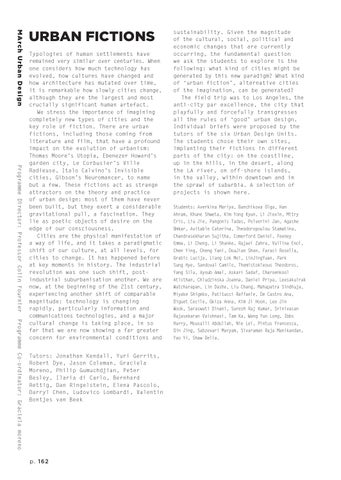M A rc h U rb a n D e s i gn
URBAN FICTIONS
Programme Director: Professor Colin Fournier Programme Co-ordinator: Graciela moreno
Typologies of human settlements have remained very similar over centuries. When one considers how much technology has evolved, how cultures have changed and how architecture has mutated over time, it is remarkable how slowly cities change, although they are the largest and most crucially significant human artefact. We stress the importance of imagining completely new types of cities and the key role of fiction. There are urban fictions, including those coming from literature and film, that have a profound impact on the evolution of urbanism: Thomas Moore’s Utopia, Ebenezer Howard’s garden city, Le Corbusier’s Ville Radieuse, Italo Calvino’s Invisible cities, Gibson’s Neuromancer, to name but a few. These fictions act as strange attractors on the theory and practice of urban design: most of them have never been built, but they exert a considerable gravitational pull, a fascination. They lie as poetic objects of desire on the edge of our consciousness. Cities are the physical manifestation of a way of life, and it takes a paradigmatic shift of our culture, at all levels, for cities to change. It has happened before at key moments in history. The industrial revolution was one such shift, postindustrial suburbanisation another. We are now, at the beginning of the 21st century, experiencing another shift of comparable magnitude: technology is changing rapidly, particularly information and communications technologies, and a major cultural change is taking place, in so far that we are now showing a far greater concern for environmental conditions and Tutors: Jonathan Kendall, Yuri Gerrits, Robert Dye, Jason Coleman, Graciela Moreno, Philip Gumuchdjian, Peter Besley, Ilaria di Carlo, Bernhard Rettig, Dan Ringelstein, Elena Pascolo, Darryl Chen, Ludovico Lombardi, Valentin Bontjes van Beek
p. 1 6 2
sustainability. Given the magnitude of the cultural, social, political and economic changes that are currently occurring, the fundamental question we ask the students to explore is the following: what kind of cities might be generated by this new paradigm? What kind of ‘urban fiction’, alternative cities of the imagination, can be generated? The field trip was to Los Angeles, the anti-city par excellence, the city that playfully and forcefully transgresses all the rules of ‘good’ urban design. Individual briefs were proposed by the tutors of the six Urban Design Units. The students chose their own sites, implanting their fictions in different parts of the city: on the coastline, up in the hills, in the desert, along the LA river, on off-shore islands, in the valley, within downtown and in the sprawl of suburbia. A selection of projects is shown here. Students: Averkina Mariya, Banchikova Olga, Han Ahram, Khune Shweta, Kim Yong Kyun, Li Jiexin, Mitry Cris, Liu Jie, Pangonis Tadas, Polverini Jan, Agashe Omkar, Avitable Caterina, Theodoropoulou Stamatina, Chandrasekharan Sujitha, Comerford Daniel, Feeney Emma, Li Cheng, Li Shanke, Rajaei Zahra, Vallina Enol, Chen Ying, Cheng Yani, DouJian Shan, Faraci Rosella, Grabic Lucija, Liang Lok Mei, LinJingYuan, Park Sung Hye, Sandoval Camilo, Themistokleous Theodoros, Yang Silu, Ayoub Amal, Askari Sadaf, Charoenkool Atisthan, Chludzinska Joanna, Daniel Priya, Leesakulrak Watcharapan, Lin Dashe, Liu Chang, Mahapatra Sindhuja, Miyake Shigeko, Patitucci Raffaele, De Castro Ana, Diguet Cecile, Gkiza Anna, Kim Ji Hoon, Lee Jin Wook, Saraswati Dinani, Suresh Raj Kumar, Srinivasan Rajasekaran Vaishnavi, Tam Ka, Wang Yun Long, Ibbs Harry, Mousalli Abdullah, Nie Lei, Pintus Francesca, Qin Jing, Sabzevari Maryam, Sivaraman Raja Manikandan, Yao Yi, Shaw Delia.
